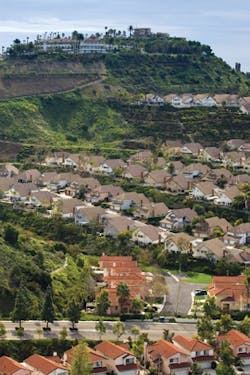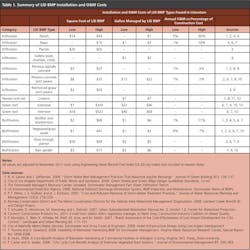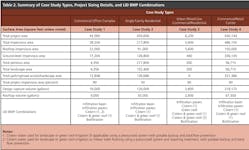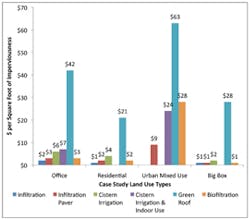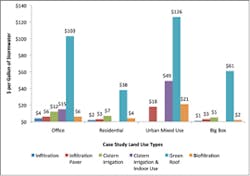With fourth-generation municipal separate storm sewer system (MS4) permits in California now requiring use of low-impact-development (LID) stormwater best management practices (BMPs) for discretionary new and redevelopment projects, the need for accurate LID BMP cost data has never been greater. Indeed, for development project proponents and the regulated MS4s, the data are fundamental both for informing the LID BMP selection process through technical and economic feasibility analysis, and for creating the basis of an appropriate mitigation or in-lieu fee in instances where a project proponent cannot meet runoff retention requirements entirely using LID BMPs onsite. To address this need, the County of Orange, on behalf of the Orange County Stormwater Program, partnered with the Construction Industry Coalition on Water Quality (CICWQ) to develop estimates of the costs of incorporating different combinations of LID BMPs into several of the most commonly encountered Orange County development scenarios.
The work presented here examines the installation and 20-year operation and maintenance (O&M) costs of installing LID BMPs using case study scenarios with design detail information provided by a number of different sources available to the cost-estimating team assembled. LID BMP cost information was also compiled through a literature review to enable comparison of the engineering cost estimates with other relevant work. Monetizable and non-monetizeable benefits derived from installing and using LID BMPs in the specific case studies analyzed are not examined in this article, but are the subject of a separate ongoing analysis that will combine installation, O&M, whole-life-cycle, and cost-benefit analysis.
Literature Reports of LID BMP Installation and O&M Costs
The literature review identified peer-reviewed journal articles, reports, guidance documents, literature reviews, and other publications that contained some type of information related to LID BMP costs. The literature found can be categorized into discussions of general LID BMP cost considerations, comparisons of LID BMP costs to those of traditional stormwater infrastructure (e.g., curb and gutter, catch basin inserts, and conventional treatment control), presentation of actual or hypothetical project cost data including the cost for O&M, and reports or discussions of LID BMP cost-benefit or whole-life-cycle cost analyses. A subset of the literature sources was then selected based on utility and comparability to the intent of the study reported here, data extracted and categorized, and then other smaller data subsets extracted according to data type on particular LID BMPs. Normalizing the data on a per-square-foot (of the LID BMP itself), per-square-foot of contributing impervious area, or per-gallon or per-cubic-foot-managed basis appears to produce the most useful expressions of LID BMP cost data and to be the most common measurements found in the literature, allowing comparison among LID BMP categories and types within categories.
Cost Estimating Methods and Assumptions
A case study approach was selected as a method for determining costs of installing, operating, and maintaining LID BMPs that meet the onsite DCV and treatment control standards specified in the north Orange County model water quality management plan (WQMP). The case studies are conceptual project development scenarios representing development types thought to most likely be constructed in Orange County. Data (property layout and design details) for conceptual case studies were supplied from several sources, including conceptual project design data used by the Orange County Public Works technical consultants to evaluate engineering feasibility scenarios (Orange County WQMP development stakeholder process); data from case studies used in a 2009 Geosyntec report titled “Low Impact Development Metrics in Stormwater Permitting”; plans and specifications for typical big box development scenarios provided by Near-Cal Corp.; parking layout and structure details provided by Choate Parking Consultants Inc.; design drawings and plans and specifications from CICWQ members; and vendors of LID BMP stormwater management products and systems including Contech Construction Products, Filterra Bioretention Systems, and Orco Block Company.
The cost estimates developed for this study were prepared using labor costs based on the prevailing wages in Section 1773.2 of the California Board of Industrial Relations Labor Code. Material costs are based on building materials pricing in the Orange County area as of April 2011. The equipment cost rates are based on the 2010 edition of the “Blue Book” prepared by Blue Book International. A team of engineers, contractors, and vendors with appropriate construction and maintenance experience was used for estimating costs.
Results
The case studies examined four different development project scenarios ranging in size from a small urban mixed-use commercial retail and residential property with no parking provided (0.14 acre), up to a large “big-box” type commercial retail center on 12.4 acres. In three of the four scenarios, the percentage of impervious area assumed was 90%, with LID BMPs sited predominately within landscaping and parking areas. Five different LID BMPs were considered for application within the four hierarchical categories of LID BMPs: infiltration basins and concrete pavers, harvest and use cisterns, green roofs, and biofiltration systems. LID BMP total installation costs and O&M costs ranged from just over $50,000 for an infiltration paver system serving the small urban mixed-use residential and commercial scenario (0.14 acre, 2,800-gallon DCV) up to $4.7 million for a cistern and green roof combination serving the 12.4-acre big-box commercial project (Table 3).
Discussion
Assuming no technical infeasibility constraints, the least-cost LID BMPs are infiltration and biofiltration systems, regardless of volume managed or project type (Figures 1 and 2). Where space is available within a project site (the case studies assumed 3% or less of the total site area) to install an infiltration basin or biofiltration system, the cost of installing these two types of LID BMPs is under $4 per gallon and $2 per square foot of TIA. The analysis shows that infiltration systems are less expensive to install than biofiltration systems. The infiltration basin costs reflect the use of hydrodynamic separation units for pretreatment; biofiltration systems may be used as well for pretreatment, but they are more expensive, generally, than hydrodynamic separators. However, they can be used to provide a greater level of pretreatment than hydrodynamic separators for certain pollutants, such as metals and some nutrients.
Conclusions
This study evaluated five different types of LID BMPs for application in Orange County, CA, land development projects using a case study approach. Data developed showed that infiltration and biofiltration systems were the least-cost practice to manage the DCV for a given project, and the least costly BMPs to operate and maintain over a 20-year period. This finding is generally consistent with a small amount of published literature and reports on LID BMP costs in the US.
